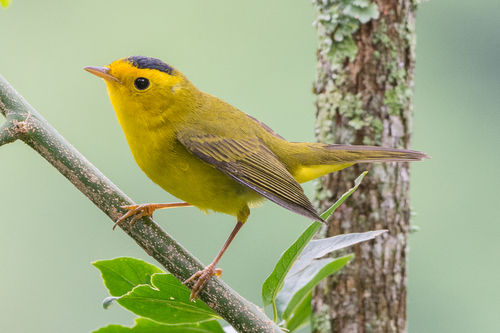
Wilson's Warbler
Wilson's Warbler (*Cardellina pusilla*) is a small, active songbird known for its bright yellow underparts and distinctive black cap (in males). It plays a vital role in controlling insect populations within its breeding and wintering habitats. While not globally threatened, its populations are sensitive to habitat loss and changes in insect abundance. This species is named after the famed ornithologist Alexander Wilson. It holds no particular cultural significance other than being a welcome sight for birdwatchers due to its vibrant colors.
10-12 cm
Length
14-17 cm
Wingspan
Least Concern
Conservation Status
Distribution
Breeds across much of Canada and Alaska, extending south into the western United States. Migrates to wintering grounds in Mexico and Central America. Altitudinal range varies from sea level to over 3,000 meters.
Lifespan
Typically 1-3 years in the wild, with a maximum recorded lifespan of around 6 years.
Wilson's Warbler's Habitat
Habitat Types
Riparian thickets, Shrubby areas, Forest edges, Bogs, Tundra
Climate Zones
Boreal, Temperate, Subtropical (wintering grounds)
Adaptations
Agile movements and small size allow it to navigate dense vegetation effectively while foraging for insects.
Variations
Three subspecies are generally recognized: *C. p. pusilla*, *C. p. pileolata*, and *C. p. chryseola*. These differ subtly in plumage coloration and size, with western populations generally being brighter yellow.
Appearance
Breeding Plumage
Males in breeding plumage have a bright yellow body with a distinct black cap. Females and immature birds have a duller yellow body and may lack the black cap or have only a faint one.
Seasonal Feather Changes
Some slight dulling of colors may occur outside of the breeding season.
Sex Based Plumage Differences
Significant; males have a prominent black cap, while females have a reduced or absent cap.
Notable Features
Small size, Bright yellow underparts, Black cap (males), Thin, pointed bill
Diet and Feeding
Primary Foods
Insects, Spiders, Small invertebrates
Foraging Behavior
Actively gleans insects from leaves and branches, often hovering briefly. May also catch insects in mid-air (flycatching).
Specializations
Its small, pointed bill is well-suited for picking small insects from foliage.
Seasonal Diet Variations
Diet is almost exclusively insects during the breeding season. May consume small amounts of berries and fruits during migration and in winter.
Behavior
Social Structure
Generally solitary or in pairs during the breeding season. May form small flocks during migration and on wintering grounds.
Communication
High-pitched, thin 'tsip' calls, A simple, buzzy song: 'chi chi chi chi chi-ch-ch'
Migration
A long-distance migrant. Travels between breeding grounds in North America and wintering grounds in Mexico and Central America. Migrates at night.
Territorial or Group Behaviors
Males defend breeding territories through song and chases. Not strongly territorial on wintering grounds.
Conservation
Threats
Habitat loss (both breeding and wintering grounds), Pesticide use (reducing insect prey), Climate change (potential impacts on habitat and insect availability), Collisions with windows
Protection Programs
Habitat conservation efforts by various organizations, Monitoring programs (e.g., Breeding Bird Survey)
Local National Laws
Protected under the Migratory Bird Treaty Act in the United States and Canada.
Population Trend
Slightly Decreasing
Population Estimates
Estimated global population of around 64 million.
Interesting Facts
They are one of the smallest North American warblers.
Their small size allows them to exploit a niche of foraging for small insects in dense vegetation.
Wilson's Warblers undertake impressive migrations.
Some individuals travel thousands of kilometers between their breeding and wintering grounds.
The female Wilson's Warbler builds the nest.
She weaves a cup shaped nest on or near the ground.
Faqs about Wilson's Warbler
What do Wilson's Warblers eat?
They primarily eat insects and other small invertebrates.
Where do Wilson's Warblers nest?
They build cup-shaped nests low in shrubs or on the ground.
Are Wilson's Warblers endangered?
No, they are currently listed as a species of Least Concern by the IUCN, but their populations are declining slightly.
How can I attract Wilson's Warblers to my yard?
Providing dense, native shrubs and avoiding pesticide use can help create suitable habitat for foraging and nesting during migration or the breeding season, if your location is within their range.
Copyright @ Nature Style Limited. All Rights Reserved.
 English
English